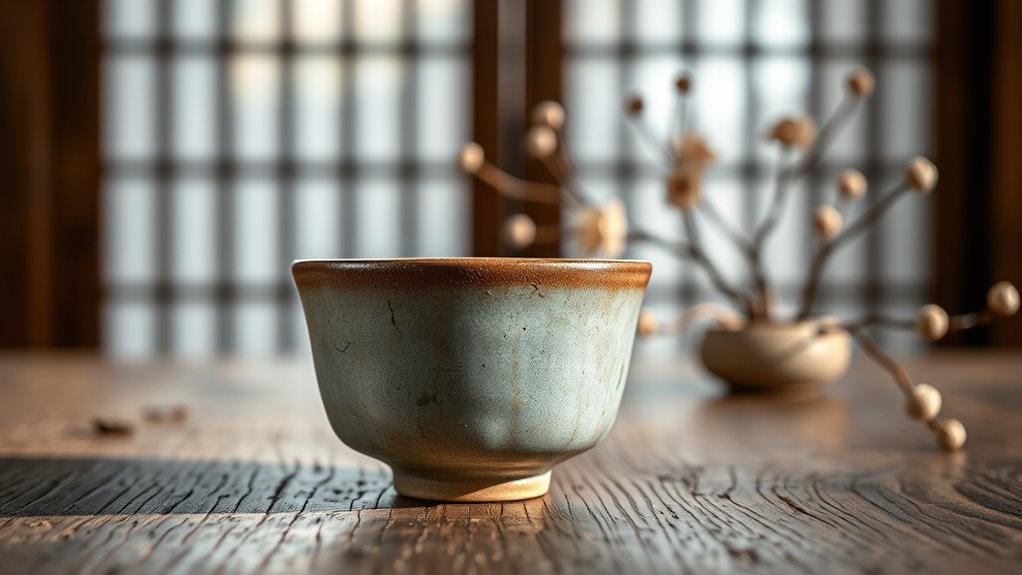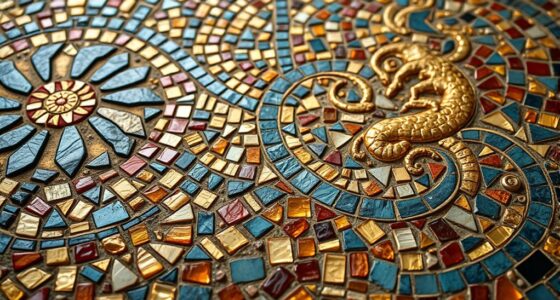Wabi Sabi is a traditional Japanese aesthetic that finds beauty in imperfection, simplicity, and transience. It emphasizes natural materials, weathered textures, and asymmetry, celebrating life’s fleeting moments and humble, rustic objects. Rooted in Zen philosophy, it encourages mindfulness and acceptance of life’s imperfections. If you explore further, you’ll discover how Wabi Sabi influences art, architecture, and daily life through authentic, sustainable design that honors natural beauty and the passage of time.
Key Takeaways
- Wabi Sabi is a Japanese aesthetic emphasizing simplicity, imperfection, and transience, rooted in Zen philosophy and tea culture.
- It celebrates natural textures, aged materials, and asymmetry, highlighting beauty in flaws and weathered surfaces.
- Wabi Sabi values humility, understated elegance, and mindfulness, fostering tranquility and authentic appreciation of impermanence.
- It influences traditional arts like ceramics, ikebana, and architecture, promoting rustic, handcrafted, and eco-friendly design.
- In modern life, Wabi Sabi encourages embracing natural cycles, imperfections, and subtle details for a mindful, genuine aesthetic.
The Origins and History of Wabi Sabi
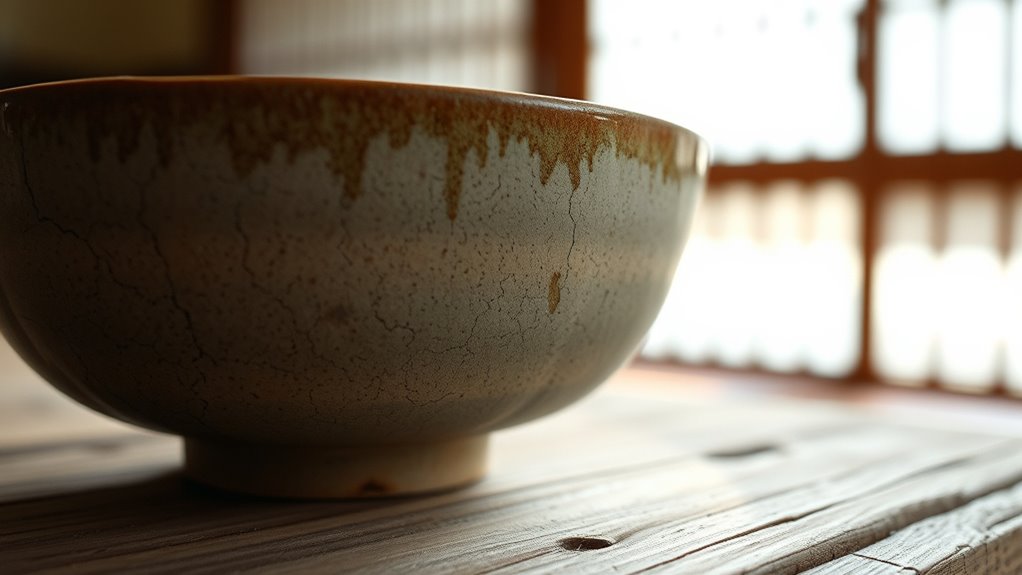
Wabi Sabi, a core concept in traditional Japanese aesthetics, has roots that date back to the Muromachi period (14th to 16th centuries). During this time, the tea ceremony emerged as a reflection of Zen philosophy, emphasizing simplicity and mindfulness. You can see how the aesthetic values of Wabi Sabi align with Zen ideals—embracing imperfection, humility, and transience. The tea ceremony became more than just preparing tea; it became a ritual that encourages you to appreciate the beauty in humble, rustic objects and fleeting moments. This connection to Zen philosophy helped shape Wabi Sabi’s focus on authenticity and naturalness, guiding you to find beauty in the imperfect and the transient aspects of life. Additionally, the influence of traditional arts like ikebana and ceramics further exemplifies Wabi Sabi’s appreciation for natural materials and handcrafted imperfections.
Core Principles of Wabi Sabi
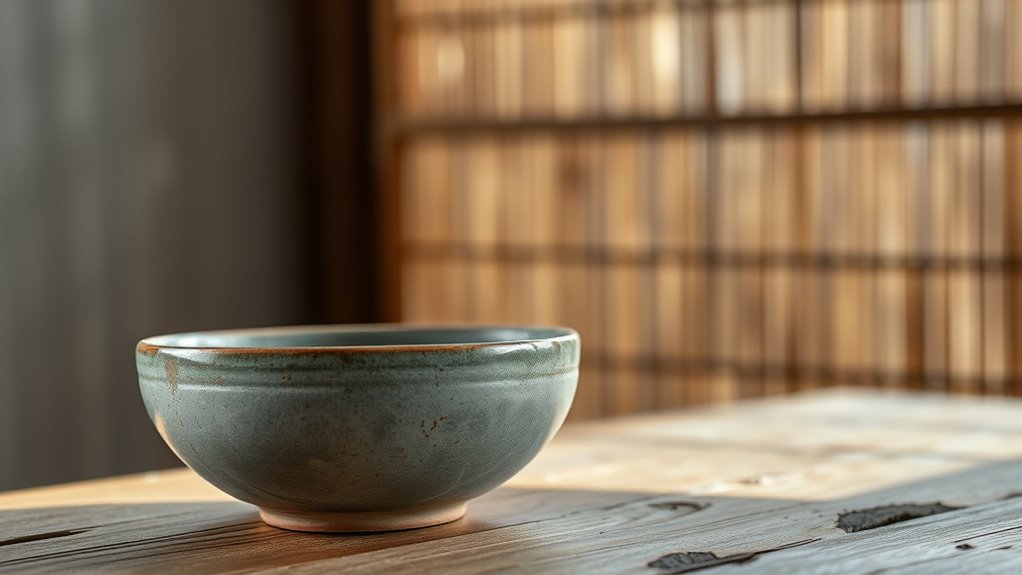
At the heart of Wabi Sabi lie several core principles that define its unique aesthetic. You’ll notice an embrace of rustic charm, where imperfections and age add character and authenticity. This rustic quality highlights the beauty in things that are worn or weathered, reminding you that impermanence is natural. Silent serenity is another key principle, encouraging a sense of calm and mindfulness. Wabi Sabi values simplicity and understated elegance, allowing you to appreciate subtle details without distraction. It invites you to find beauty in the imperfect, transient, and incomplete. Recognizing the importance of aesthetic principles, Wabi Sabi encourages a mindful appreciation of life’s fleeting moments. By embracing these principles, you create a space or mindset rooted in humility, tranquility, and a deep appreciation for life’s fleeting moments.
Wabi Sabi in Traditional Japanese Art
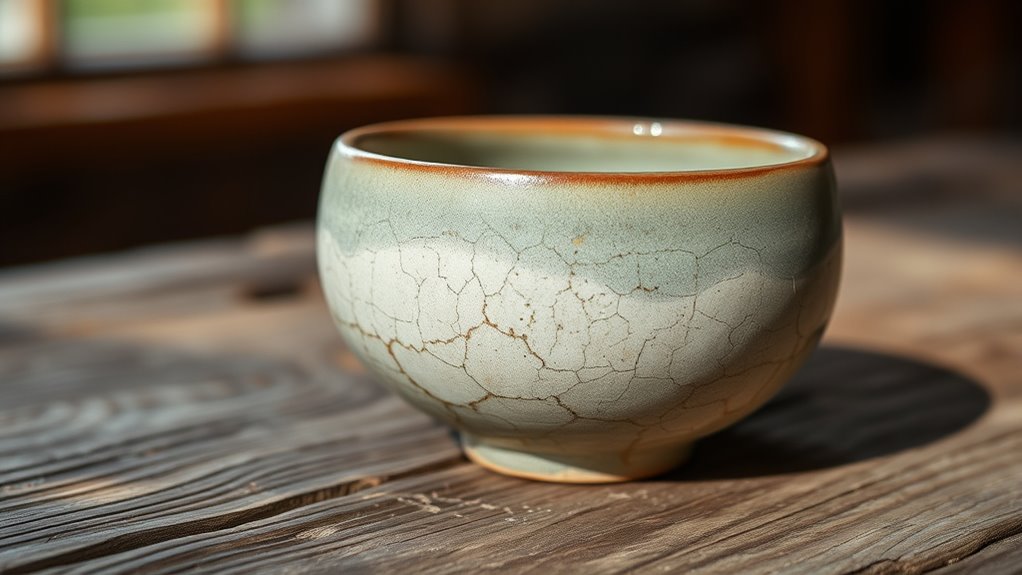
Traditional Japanese art vividly embodies Wabi Sabi’s principles through its emphasis on simplicity, natural materials, and subtle imperfections. In the tea ceremony, you notice the humble, rustic utensils and uneven textures that highlight imperfection, creating an atmosphere of quiet elegance. Similarly, ikebana arrangements focus on asymmetry and natural growth, emphasizing the beauty of organic forms and imperfections. Both practices celebrate transient beauty and the understated, avoiding ornate or overly polished elements. You’re encouraged to appreciate the imperfect, the aged, and the simple, which evoke a sense of tranquility and authenticity. Through these art forms, Wabi Sabi teaches you to find beauty in the imperfect and transient moments, fostering a deep connection to nature and the present. Additionally, understanding the bias in AI outputs and the importance of continuous monitoring can deepen your appreciation for authenticity and subtlety, much like the principles of Wabi Sabi.
Architectural Expressions of Wabi Sabi
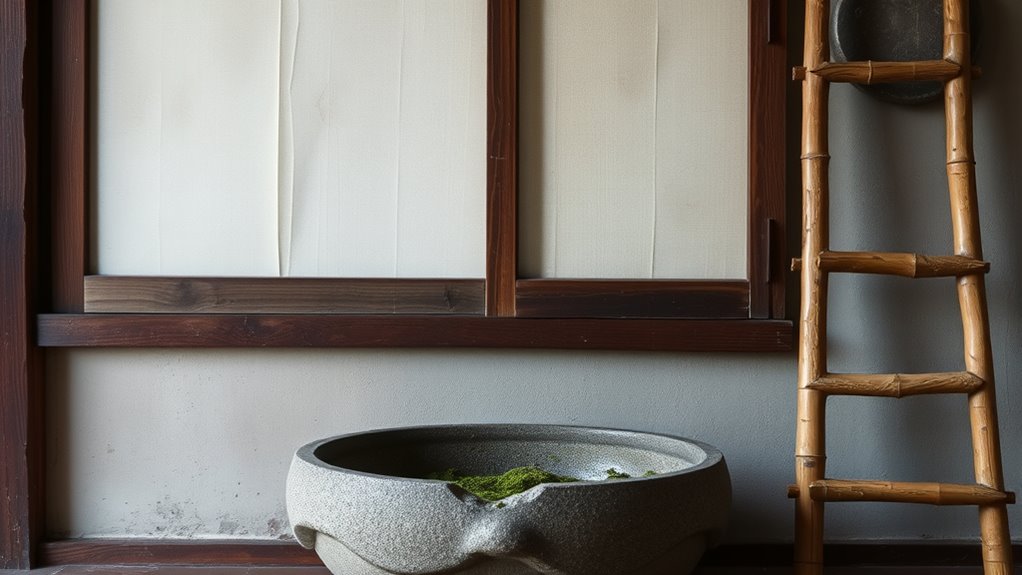
In traditional Japanese architecture, you notice how imperfect materials like rough wood and uneven plaster create a sense of authenticity. Asymmetrical design elements break away from strict symmetry, emphasizing natural beauty and simplicity. Weathered surfaces and natural aging highlight the aesthetic of wabi sabi, celebrating the beauty of impermanence. Additionally, the use of self watering plant pots in traditional settings demonstrates how functionality aligns with aesthetic principles, emphasizing harmony with nature.
Imperfect Materials Use
Imperfect materials are central to expressing Wabi Sabi in Japanese architecture, emphasizing beauty in flaws and transience. You notice how ceramic cracks add character, showcasing the history and aging process of pottery. Aged textiles, with their visible wear, evoke a sense of time passing and natural beauty. These materials celebrate imperfections rather than hide them, creating a sense of harmony and authenticity. To illustrate, consider this table:
| Material | Characteristic | Wabi Sabi Significance |
|---|---|---|
| Ceramic Cracks | Visible fractures, history | Embrace imperfections, age as beauty |
| Aged Textiles | Faded colors, wear marks | Transience, authenticity |
| Rough Wood | Weathered surface | Natural, unrefined aesthetic |
Additionally, the use of natural materials like stone and clay further enhances the organic, humble aesthetic characteristic of Wabi Sabi.
Asymmetrical Design Elements
Asymmetrical design elements are a defining feature of Wabi Sabi architecture, emphasizing naturalness and subtle imperfection. You’ll notice how asymmetrical balance creates a sense of harmony without strict symmetry, reflecting the beauty of irregular patterns found in nature. Buildings often feature uneven rooflines, off-center doorways, and varied window placements that evoke a feeling of organic authenticity. These irregular patterns avoid perfection, instead celebrating the unique character of each element. By embracing asymmetry, designers invite you to appreciate the understated elegance that comes from imperfection. This approach fosters a calming, unpretentious atmosphere, where every detail feels thoughtfully imperfect yet complete. Incorporating rustic materials further enhances this aesthetic by adding textures and visual interest that celebrate natural variation. Ultimately, asymmetrical design enhances the aesthetic, making spaces feel more authentic and connected to the natural world.
Natural Weathering Aesthetics
Natural weathering reveals the beauty of age and exposure, turning ordinary surfaces into expressive elements of Wabi Sabi architecture. Weathered textures showcase organic aging, emphasizing impermanence and natural processes. You’ll notice how rust, patina, and erosion add depth and character, transforming simple materials into poetic expressions of time. These signs of aging aren’t flaws but integral to the aesthetic, highlighting authenticity and humility. As surfaces age naturally, they develop subtle variations that evoke a sense of history and tranquility. You’re encouraged to appreciate the imperfect beauty that weathered textures bring, celebrating the passage of time. This approach fosters a connection to nature and emphasizes that beauty isn’t static but evolves gracefully through organic aging. Additionally, Weathered textures often incorporate natural materials that exemplify the principles of Wabi Sabi, emphasizing harmony with the environment and the passage of time.
Wabi Sabi in Contemporary Design
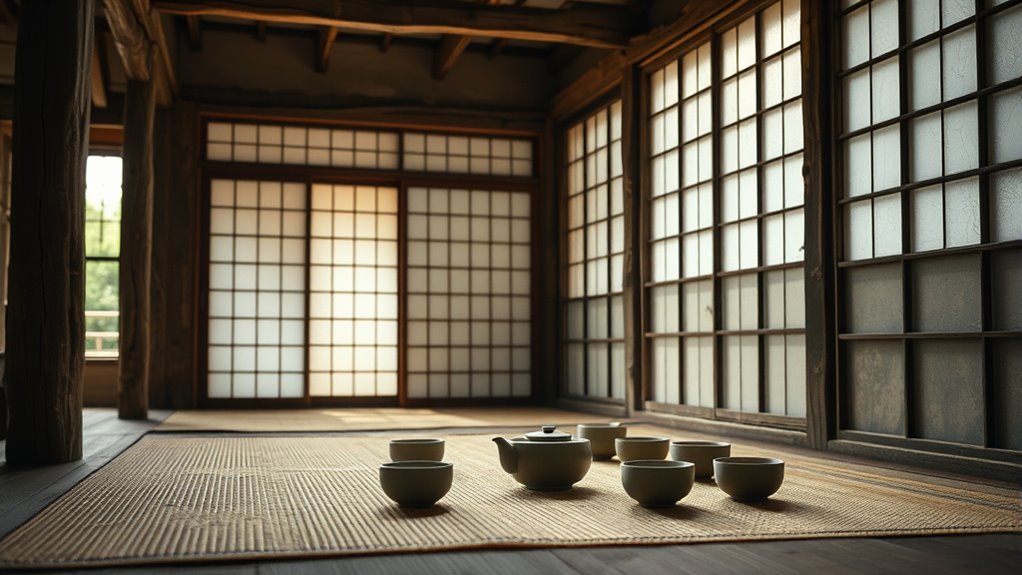
You notice how modern designs often incorporate Wabi Sabi through minimalist aesthetics that highlight natural imperfection. By choosing sustainable materials, designers create spaces that feel authentic and environmentally conscious. This blend of simplicity and honesty keeps traditional Wabi Sabi relevant in contemporary settings. Incorporating versatility of hybrid bikes principles into design emphasizes adaptability and practicality, resonating with Wabi Sabi’s appreciation for functional beauty.
Minimalist Approach Integration
In contemporary design, the minimalist philosophy of Wabi Sabi finds a fresh expression by emphasizing simplicity, imperfection, and the beauty of transient moments. You can incorporate these ideas through clean lines, muted colors, and natural materials that evoke calmness. Think of serene zen gardens or understated tea ceremonies—spaces where imperfections highlight authenticity. To integrate Wabi Sabi seamlessly, focus on decluttering and embracing asymmetry, which creates a sense of harmony and mindfulness. This approach encourages you to appreciate the beauty in the unfinished and the imperfect. By doing so, you craft environments that feel both modern and rooted in traditional Japanese aesthetics, fostering a sense of tranquility and authenticity.
- Use natural, textured materials like wood and stone
- Embrace asymmetry in furniture and decor
- Incorporate subtle imperfections to add character
Embracing Imperfection Naturally
Embracing imperfection naturally is at the heart of Wabi Sabi, a philosophy that celebrates the beauty found in flaws and transience. In contemporary design, you often see this reflected through handcrafted pottery with uneven glazes and aged wood with visible grain and marks. These elements evoke authenticity and character, reminding you that beauty doesn’t have to be perfect. Incorporate these materials intentionally, allowing their natural irregularities to shine. Below is a quick guide:
| Material | Feature |
|---|---|
| Handcrafted pottery | Unique, imperfect shapes |
| Aged wood | Rich texture, natural aging |
| Stone | Weathered surface, organic look |
Additionally, understanding the cultural significance of Wabi Sabi can deepen your appreciation and application of these aesthetics in your space.
Sustainable Material Use
Integrating sustainable materials aligns seamlessly with the Wabi Sabi philosophy, which values natural beauty and the passage of time. By choosing eco-friendly practices and focusing on renewable resource utilization, you honor nature’s cycles and imperfections. This approach encourages using materials like bamboo, reclaimed wood, and recycled metals that age gracefully. It also promotes designs that reflect simplicity and authenticity, emphasizing the beauty of natural materials in their raw state. Additionally, understanding affiliate marketing disclosures ensures transparency when sharing sustainable products or practices with others. Practicing sustainable material use helps you create spaces that resonate with Wabi Sabi’s appreciation for impermanence and natural beauty.
Embracing Imperfection in Daily Life
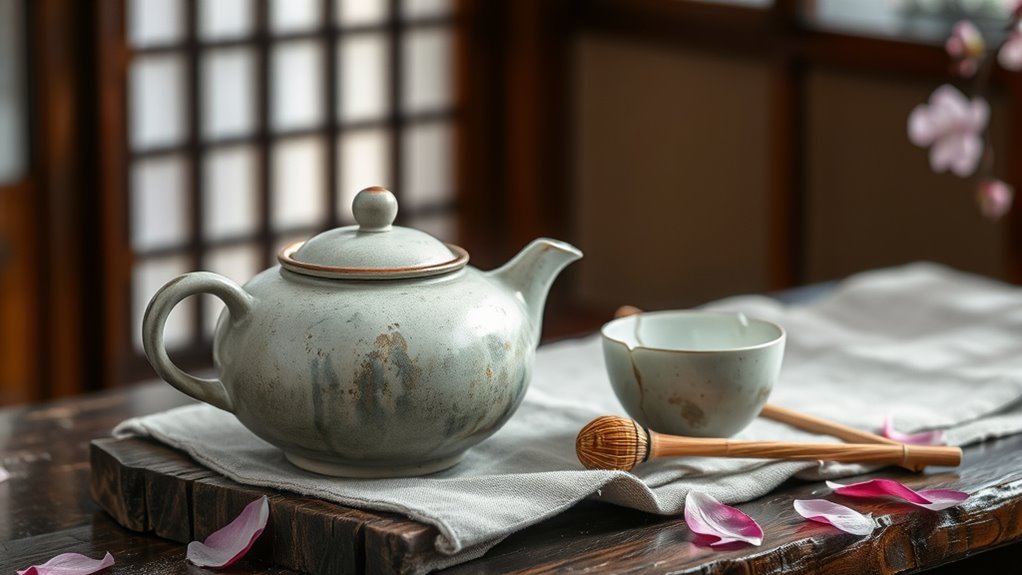
Rather than aiming for perfection in every detail, Japanese aesthetics encourage you to find beauty in the flaws and irregularities of daily life. You might appreciate blemished ceramics that reveal their history through cracks or uneven glazing, reminding you that imperfection adds character. Similarly, an asymmetrical garden with uneven stones and wild plants reflects natural harmony over symmetry. Embracing these imperfections helps you slow down and notice the beauty in everyday moments, rather than *aspiring* for flawlessness. This mindset encourages you to accept and even celebrate life’s unpredictability. By doing so, you foster a deeper appreciation for authenticity and resilience, understanding that true beauty often lies in the imperfect, the asymmetrical, and the flawed. Recognizing the value of wabi-sabi in everyday objects and environments can deepen your understanding of this aesthetic philosophy.
Wabi Sabi and Nature’s Ephemeral Beauty
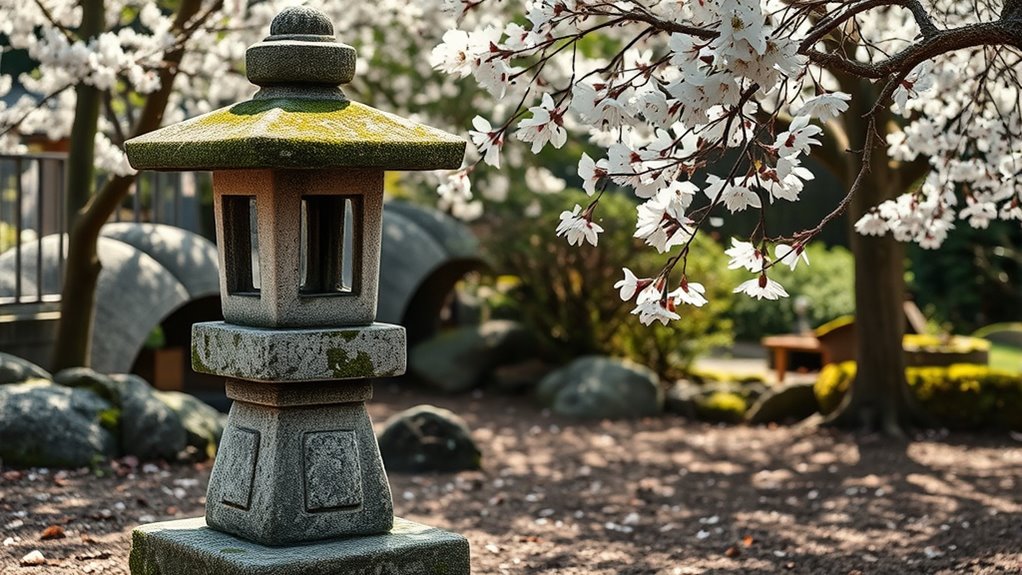
Have you ever noticed how the fleeting bloom of cherry blossoms captures the essence of impermanence in Japanese culture? Wabi Sabi celebrates this transient beauty found in nature, reminding you to appreciate life’s fleeting moments. During a flower arrangement, you might select blooms that are just starting to fade, emphasizing their natural cycle. In a tea ceremony, the changing seasons and delicate imperfections highlight the beauty of impermanence. These practices encourage you to find elegance in decay and transience. By observing nature’s ephemeral qualities—like falling leaves or wilting flowers—you learn to accept imperfection and appreciate each moment. Wabi Sabi invites you to see beauty in life’s temporary, imperfect, and humble aspects, deepening your connection to nature’s fleeting artistry.
Cultivating Wabi Sabi Mindset Today
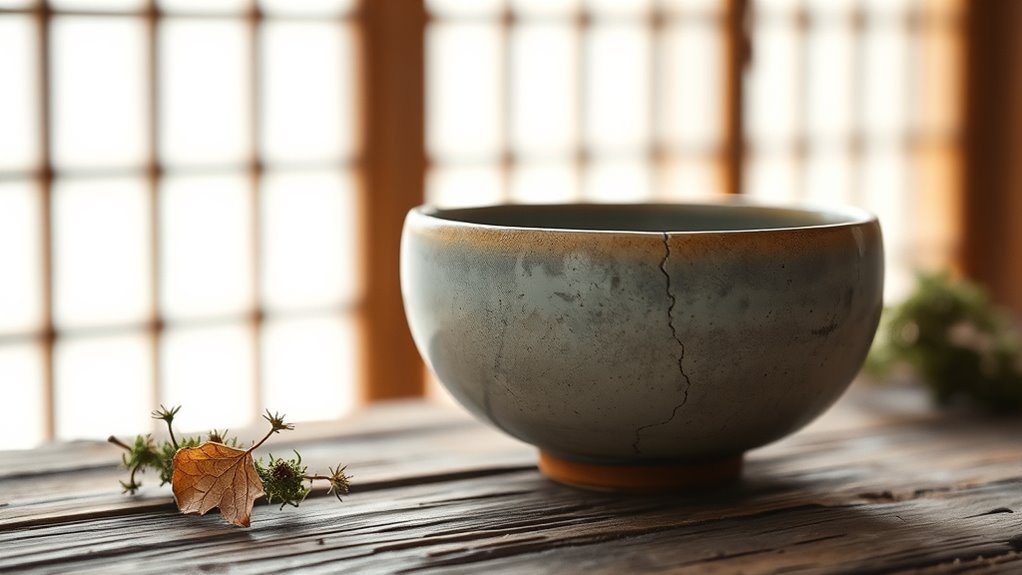
Embracing the Wabi Sabi mindset today involves shifting your perspective to find beauty in imperfection and transience in everyday life. Inspired by zen philosophy, you learn to appreciate simplicity and the natural flow of life. Practicing mindful living helps you slow down, notice small details, and accept life’s imperfections without judgment. You might begin by decluttering your space, embracing handmade objects, or savoring quiet moments. By doing so, you cultivate a sense of peace and authenticity that aligns with Wabi Sabi’s core values. This mindset encourages you to value the fleeting nature of beauty, fostering resilience and humility. Understanding ethical hacking principles can also teach you to recognize vulnerabilities in your environment, promoting a more secure and aware mindset. Ultimately, it transforms how you see yourself and the world, guiding you toward a more genuine and harmonious existence.
Frequently Asked Questions
How Does Wabi Sabi Influence Modern Lifestyle Choices?
Wabi sabi influences your modern lifestyle by encouraging a minimalist approach, helping you focus on what truly matters. It inspires you to appreciate imperfection and natural beauty, leading to sustainable living choices like reducing waste and valuing quality over quantity. By embracing wabi sabi, you create a more mindful, authentic environment that prioritizes simplicity, sustainability, and the beauty found in life’s imperfections.
Can Wabi Sabi Be Incorporated Into Digital Design?
You can absolutely incorporate wabi sabi into digital design, turning screens into calming, rustic aesthetics that feel alive and authentic. Embrace digital minimalism by highlighting imperfect textures, muted tones, and natural elements that celebrate beauty in imperfection. This approach creates a serene user experience, grounding technology in simplicity and authenticity. Wabi sabi’s principles breathe life into modern digital spaces, making them feel more human, warm, and genuinely imperfect.
What Are Common Misconceptions About Wabi Sabi?
You might think wabi sabi is just misunderstood minimalism, but it’s more about embracing imperfection and impermanence. Don’t overgeneralize imperfection as flaw; instead, see it as beauty and authenticity. Many believe it’s about simplicity only, but it’s about appreciating subtlety and depth. Wabi sabi encourages you to find elegance in flaws and transience, not perfection, helping you cultivate a genuine, humble aesthetic that celebrates life’s imperfections.
How Does Wabi Sabi Relate to Japanese Spirituality?
You’ll see that wabi sabi relates deeply to Japanese spirituality through Zen philosophy, emphasizing spiritual acceptance of imperfection and impermanence. It encourages you to embrace life’s natural flow and find beauty in flaws and transience. By practicing wabi sabi, you cultivate a sense of inner peace and acceptance, aligning your spirit with the subtle, humble, and serene qualities that are central to Japanese spiritual values.
Is Wabi Sabi Applicable Outside Japanese Culture?
Yes, wabi sabi is applicable outside Japanese culture because of its cultural adaptability and global relevance. You can embrace its principles of simplicity, imperfection, and transience in diverse settings, from interior design to personal philosophy. Its focus on appreciating the beauty in imperfection resonates universally, making it a meaningful approach for fostering mindfulness and authenticity regardless of cultural boundaries.
Conclusion
Embracing wabi sabi gently invites you to find beauty in life’s subtle imperfections. It reminds you to cherish fleeting moments and appreciate the understated elegance around you. By adopting this mindset, you’ll discover a richer sense of peace and authenticity in everyday life. So, let go of perfection’s grip, and allow yourself to enjoy the quiet, imperfect charm that makes life truly special. After all, it’s in these gentle flaws that true beauty resides.

